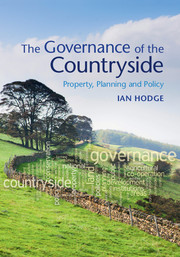Book contents
- Frontmatter
- Contents
- Preface
- Acknowledgements
- List of abbreviations
- Part I Introduction
- Part II Historical models
- Part III Governance under sectoral policies
- 6 Agricultural policies, farming and the environment
- 7 Land, development and planning
- 8 Protected Areas: the example of National Parks
- 9 Wildlife conservation: National Nature Reserves, Sites of Special Scientific Interest and Large-scale Conservation Areas
- 10 Public rights of way and access to the countryside
- 11 The control of agricultural pollution
- 12 The development of agri-environment policy
- Part IV Alternative approaches to governance
- Part V Conclusions
- References
- Index
8 - Protected Areas: the example of National Parks
from Part III - Governance under sectoral policies
Published online by Cambridge University Press: 05 February 2016
- Frontmatter
- Contents
- Preface
- Acknowledgements
- List of abbreviations
- Part I Introduction
- Part II Historical models
- Part III Governance under sectoral policies
- 6 Agricultural policies, farming and the environment
- 7 Land, development and planning
- 8 Protected Areas: the example of National Parks
- 9 Wildlife conservation: National Nature Reserves, Sites of Special Scientific Interest and Large-scale Conservation Areas
- 10 Public rights of way and access to the countryside
- 11 The control of agricultural pollution
- 12 The development of agri-environment policy
- Part IV Alternative approaches to governance
- Part V Conclusions
- References
- Index
Summary
In this wish the author will be joined by persons of pure taste throughout the whole island who by their visits often repeated to the Lakes in the North of England testify that they deem the district a sort of national property in which every man has a right and interest who has an eye to perceive and a heart to enjoy.
William Wordsworth, A Guide through the District of the Lakes in the North of England with a Description of the Scenery for the use of Tourists and Residents. Fifth Edition with Considerable Additions. Hudson and Nicholson, Kendal, 1835, p. 888.1 The rationale for protected areas
Some places have particular national or international importance in terms of the contribution their land uses make to public goods, externalities (Turner, 2002) and ecosystem services. These values are of consequence not just for people living or working in the locality, but also, perhaps even more so, for people who visit (direct use values) or who benefit from the knowledge of the conservation of the area (existence values). In this respect the management of the area becomes a legitimate interest to a broader population; the high public values of these areas warrant a higher standard of environmental management. This requires more intensive public engagement, incurring higher levels of transactions costs than is generally the case in other areas. Protected Areas are thus designated by a higher-level public authority and are the subject of special forms of governance. This will often involve some limitations over the rights of local users, positive incentives for certain types of management and direct involvement by the higher public authority. This intervention requires the development of institutions that can guide land uses and management towards the interests of the wider public. This type of arrangement applies particularly to National Parks and these are the focus of this chapter.
8.2 War-time issues and precursors
Beyond the legislation for agriculture and town and country planning, a third seminal Act of Parliament from the late 1940s opened up a new area of government involvement in the rural environment. The National Parks and Access to the Countryside Act 1949 brought together a series of issues relating to the environmental values of the countryside.
- Type
- Chapter
- Information
- The Governance of the CountrysideProperty, Planning and Policy, pp. 163 - 180Publisher: Cambridge University PressPrint publication year: 2016

